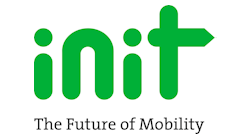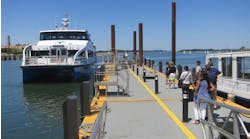It’s cold outside. Across town someone is waiting for a bus. The print schedule says it arrives at 10:05, but it is now 10:20 and no bus in sight. Just four blocks away, the bus has been re-routed due to an earlier accident. Dispatch knows the bus is off-route because the driver radioed in, but the agency can’t get that information to the passenger waiting in the cold. Even if the passenger calls to find out where the bus is, dispatch can only give an estimate and best-case scenario. No one is happy, especially the frozen, angry passenger.
This scenario is played out every day across the country. With today’s fast-paced environment and expectations for instant information, agencies know how important it is to meet passenger demands for information in real-time. The following case study outlines the challenges and changes of one agency’s service through computer-aided fleet management and real-time passenger information implementation.
MTD Gets ITS and Real-Time Information
Champaign-Urbana Mass Transit District (MTD) operates a combined fixed-route and paratransit fleet that services the cities of Champaign, Urbana, Savoy and the University of Illinois campus. MTD has won numerous awards, including two Outstanding Achievement Awards from the American Public Transportation Association (APTA) for best small transit system in America.
Despite its size, (just over 100 vehicles), MTD provides service to more than 10 million riders annually, a significant portion of which consists of the more than 40,000 students at the University of Illinois.
In 2002, the agency partnered with two smaller agencies in the state to install an integrated ITS solution from INIT, Innovations in Transportation Inc. The computer-aided dispatch/automatic vehicle location (CAD/AVL) system included all major GPS functions to support vehicle location, timetable adherence, real-time bus arrival and departure information, and on-board next stop displays and announcements.
“Implementing an ITS and real-time passenger information system requires planning and patience,” says Karl Gnadt, MTD’s director of market development. “Understand that during implementation you will experience some bumps as the new system is put in place. There is also a learning curve for your staff and your passengers.”
Control Center Goes Proactive
On the dispatch side, Tom Conrad, lead dispatcher for MTD, noticed an immediate change. The new system instantly gave him and other dispatchers the ability to provide timely responses to delays or incidents by means of service restoration actions, connection protection, transfers and headway control. “Before we had the system,” Tom explains, “we would just respond to the radio calls as they came in. Now, if we see a vehicle running early we tell them to slow down; if we see they are running late, we start another vehicle on time; if the vehicle has a maintenance problem and the bus is not in service we know exactly where they are before they even tell us.
"We no longer call this department ‘dispatch;’ we now call it The Control Center. The best feature of the system is that we are in control of all of the vehicles. Knowing this gives our drivers a sense of security because they know we are assisting them all the time by monitoring the system.”
RTPI by Phone, Web and at the Stops
One of the most important components of the system was the integrated real-time passenger information system which included wayside passenger signage displaying next bus departure times. The availability of real-time bus departure information through phones, by Web and through the traditional signage at the stops created a frenzy of activity from MTD passengers and ultimately increased MTD’s ridership numbers.
For instance, the use of MTD’s real-time text messaging feature grew exponentially after its inception in 2006. In fact, the total monthly average of texts for real-time information in 2006 was 2,492, but in 2010, that soared to 58,117. And, an all-time monthly high of 104,929 texts for real-time bus arrival and departure information (RTPI) was recorded in October of 2010.
Along with text messaging, passengers are able to trip-plan using the Internet. STOPwatch, a real-time information system found on the MTD website, uses the MTD database and Google search to assist travelers with trip planning.
According to a recent poll asking passengers which feature of the RTPI was their favorite, one passenger wrote, “SMS by far, because it's easiest to use while actually ON a bus. Website would be next, but I use that more to look up the SMS codes.”
Since its inception, the agency has experienced high demands for data with hourly requests from usersm including applications, widgets and SMS averaging nearly 35,000 per hour. In fact, 45 percent of riders indicated that the website was their primary information source about MTD in 2008. By 2010, that percentage grew to 59 percent.
Brad Cronk, MTD’s technology supervisor, advises, “Be prepared for the public to quickly become dependent on real-time information. All features of the CAD/AVL system depend upon accurate data from GPS locations and distances between stops. If a dispatcher pulls a vehicle out of service without having another to take its place, passengers down the route from the event will see buses disappear from the real-time displays. The data has to be as accurate as possible to be able to provide a great service.”
Safety and Communication
Once the real-time information system was in place, MTD staff began to operate proactively rather than reactively with service. Immediate access to performance data helped to evaluate customer service issues, make service adjustments and inform passengers about any delays. This not only enhanced customer relations, but the ability to track performance and to monitor vehicle assignments immediately improved on-time performance.
In addition, better communication between control and the operators reduced voice communications with the ability to send text messages to multiple vehicles. Operators could send pre-programmed messages rather than having to create standard messages. Transfer connections, as well as automatic alerts for such things as off-route and running early situations, could now be sent electronically. MTD Managing Director Bill Volk noted, “Operationally, the system has been invaluable, saving time and money and increasing the production and efficiency of our service to our customers.”
Another added feature, the silent safety alarms onboard the buses, enable dispatchers to receive alerts with a special message relaying the exact location of the bus on a map display when a problem arises. Control is given direct access to what is happening on the bus and can direct police and emergency personnel to the exact location of the vehicle if needed. With bus incidents on the rise, this feature of the system was a welcome component.
Lessons Learned
Karl Gnadt shares this advice from his experience. “With the system in place, it became clear that we needed to relentlessly pursue an organizational paradigm shift in how we approach on-the-street changes. Now that our passengers had a complete picture of what was happening on the street, the burden was on us to consider the possible implications that changes would have on the information that passengers had in hand.”
From a customer point of view, the availability of real-time information has changed the face of MTD’s transit culture. The scenario of a passenger waiting in the cold wondering when the next bus will arrive has become a thing of the past. Riders are well-informed and in control of their travel plans which according to a recent survey has increased their satisfaction with public transit.
“The system empowers passengers by giving them the information they need in a convenient media – whether from their home computer, their cell phone, or the signage at the stop,” says Jan Kijowski, MTD’s marketing director.
In the long run, the benefits far outweigh any challenges. MTD has realized improved on-time service, increased driver and passenger safety, instant and accurate access to real-time information for customers, and most importantly, a more efficient transit system. The successful installation, and resulting improved performance, propelled MTD’s customer satisfaction rates to an astounding 98 percent in 2010.
With the honor of being one of the highest rated agencies in customer satisfaction in the nation, MTD is a shining example of how one small agency has made a big impact in providing a more attractive, safer and more efficient public transit system in its university town.




